The kilometer-wide, potentially hazardous asteroid 1994 PC1 will fly past Earth on January 18th. Good news on two counts: It won’t hit us, and it’s bright enough to see in a 4-inch telescope.
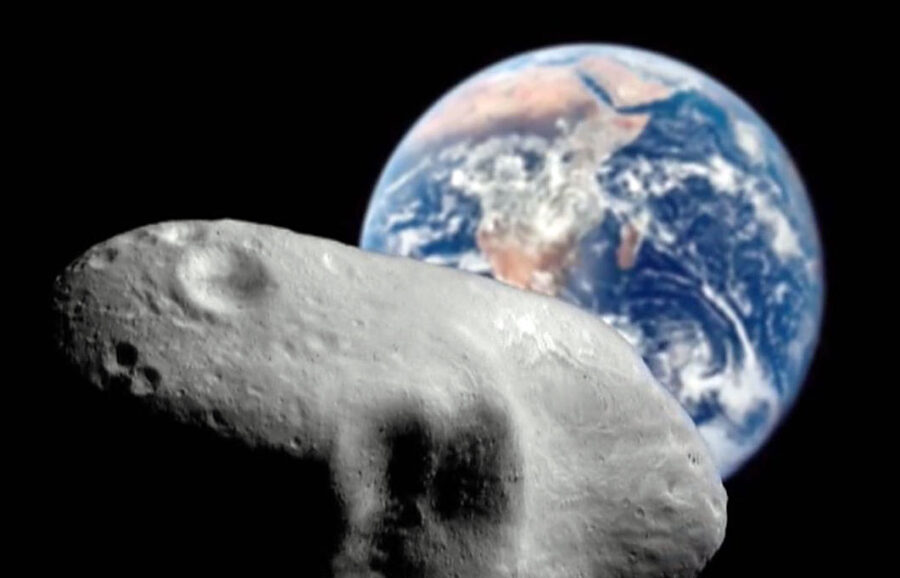
NASA
Asteroid (7482) 1994 PC1 is big and potentially hazardous, meaning that its orbit intersects Earth's. But this time around, the space rock comfortably misses Earth and instead puts on a safe show for small telescope users.
Watching a fast-moving asteroid is a total blast. Once you lock on, you're in the astronomical fast lane, cruising across star fields, making and breaking asterisms with abandon. We're so used to celestial objects moving slowly or not at all. That's what makes observing Earth-approaching asteroids such a treat. You get a taste of what cosmic velocity really means.
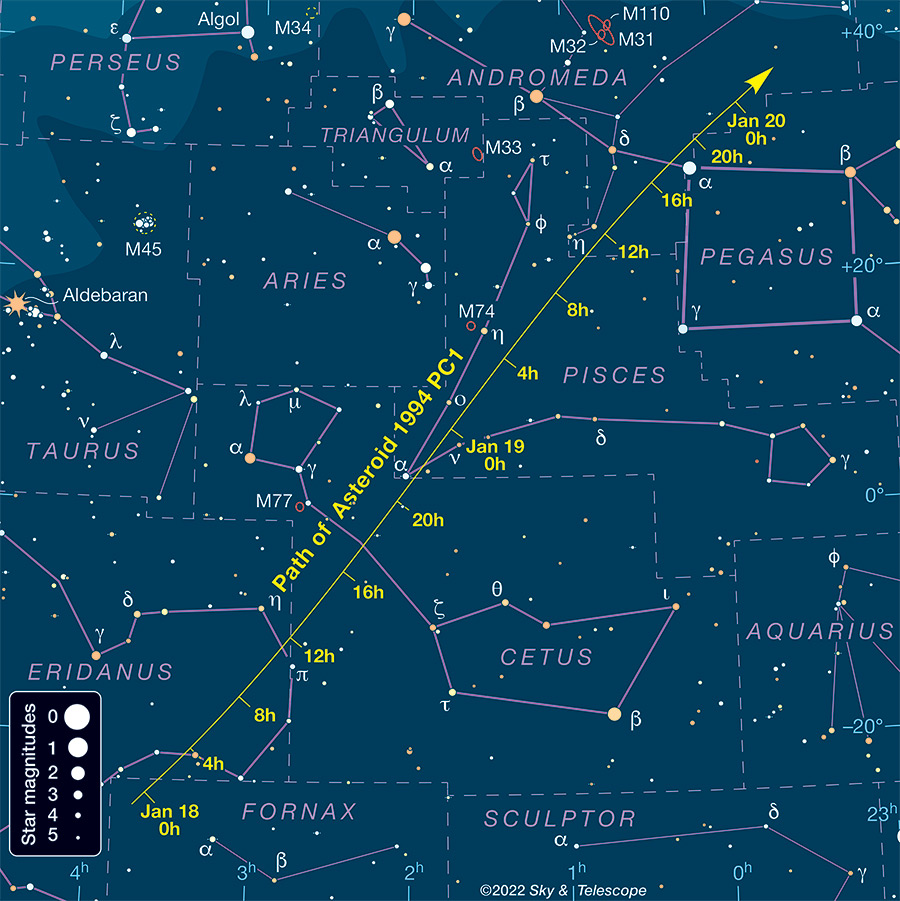
Sky & Telescope
Astronomer Robert McNaught discovered 1994 PC1 at Siding Spring Observatory in Australia on August 9, 1994, at 18th magnitude. The asteroid circles the Sun every 1.6 years in an eccentric orbit with a distance that varies from 0.9 a.u. at perihelion to 1.8 a.u. at aphelion. Astronomers place it in the potentially hazardous (PHA) category — a status it shares with about 2,000 other known asteroids — because it's larger than 140 meters (460 feet) across and passes within 0.05 a.u. (roughly 7,480,000 km or 4,650,000 miles ) of Earth's orbit.

NASA / JPL-HORIZONS
Just to be clear, 1994 PC1 poses no danger at this time — it will miss Earth by 1.9 million kilometers (1.2 million miles ) when at closest approach at 4:51 p.m. EST (21:51 UT) on Tuesday, January 18th. That's five times the Earth-Moon separation or roughly the same distance from Earth to NASA's James Webb Space Telescope. This pass will be our closest shave for at least the next 172 years. A comparable but slightly more distant flyby occurs on January 18, 2105, at 2.3 million kilometers.
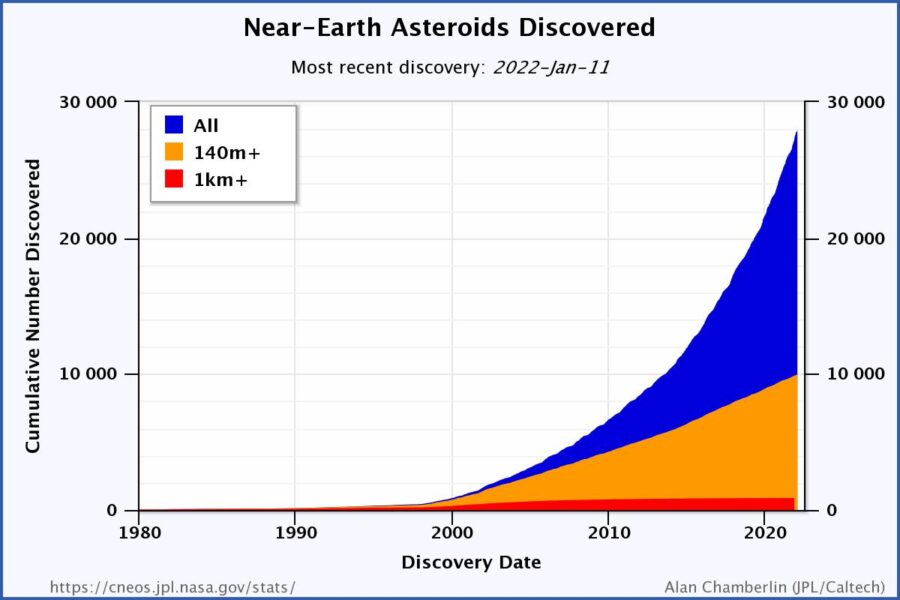
CNEOS / NASA
Asteroid 1994 PC1 measures 1.1 kilometers across. Based on its spectral type, it's a typical S-class or stony asteroid with a silicate composition. Were it to impact our planet, it would excavate a crater about 20 kilometers (12.4 miles) across. The shockwave, fireball, falling debris and powerful tsunamis (assuming an oceanic strike) would create widespread regional havoc and devastation. Fortunately, impacts of this size occur only about once every 500,000 years, leaving enough time (we hope) to find a way to deflect the inevitable, future PHA that has Earth in its crosshairs.
On January 14th, around 10 p.m. EST, our whiz kid is already at magnitude 12.2 and located in the southern constellation Pictor about 8° northwest of Canopus. Three nights later on January 17th, it brightens to magnitude 10.3 and becomes more conveniently placed for northern observers, heading northwest at about 1.5° per hour from Fornax into Eridanus. Watch for it to pass 1.5° northeast of the 9th-magnitude planetary NGC 1360 in Fornax around 7–7:30 p.m. EST.
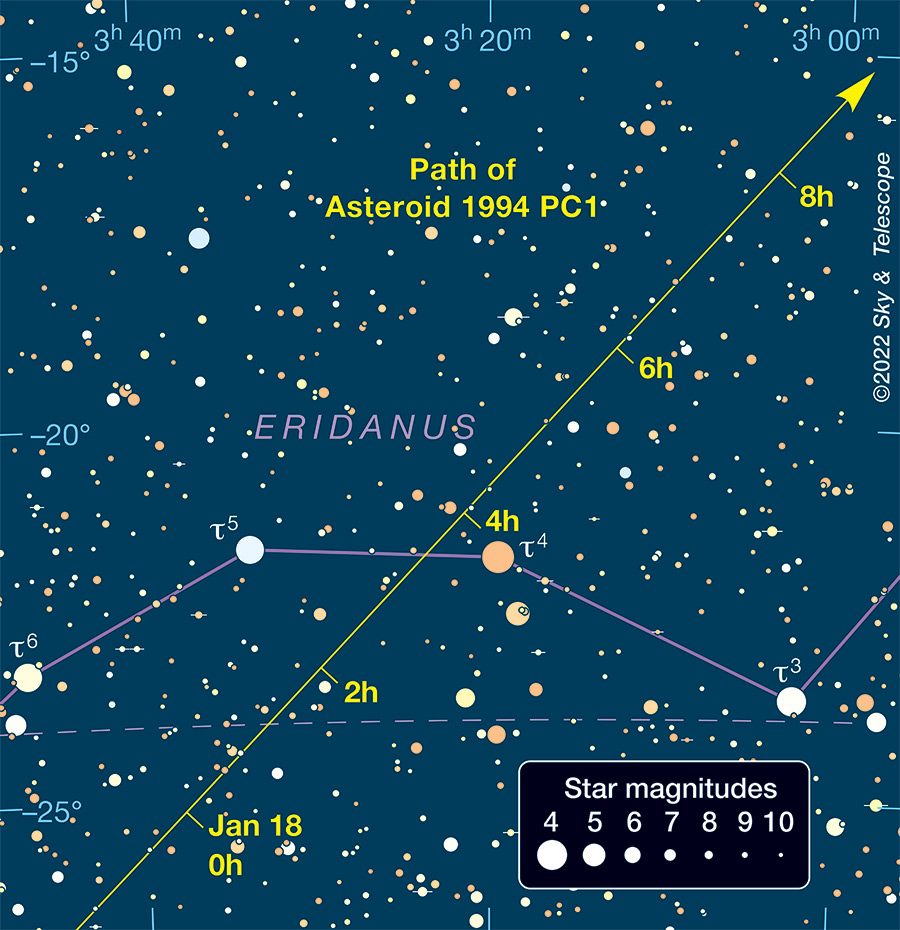
Sky & Telescope
On the evening of January 18th, asteroid 1994 PC1 comes closer yet but fades a fraction to magnitude 10.4. It tracks across eastern Pisces at the rate of 2.2° per hour or 2.2 arcminutes per minute. That's fast enough to detect its movement in real time, particularly when the asteroid passes close to a star or makes and breaks on-the-spot asterisms with field stars. Higher magnifications (100× or more) will make its apparent motion even more obvious.
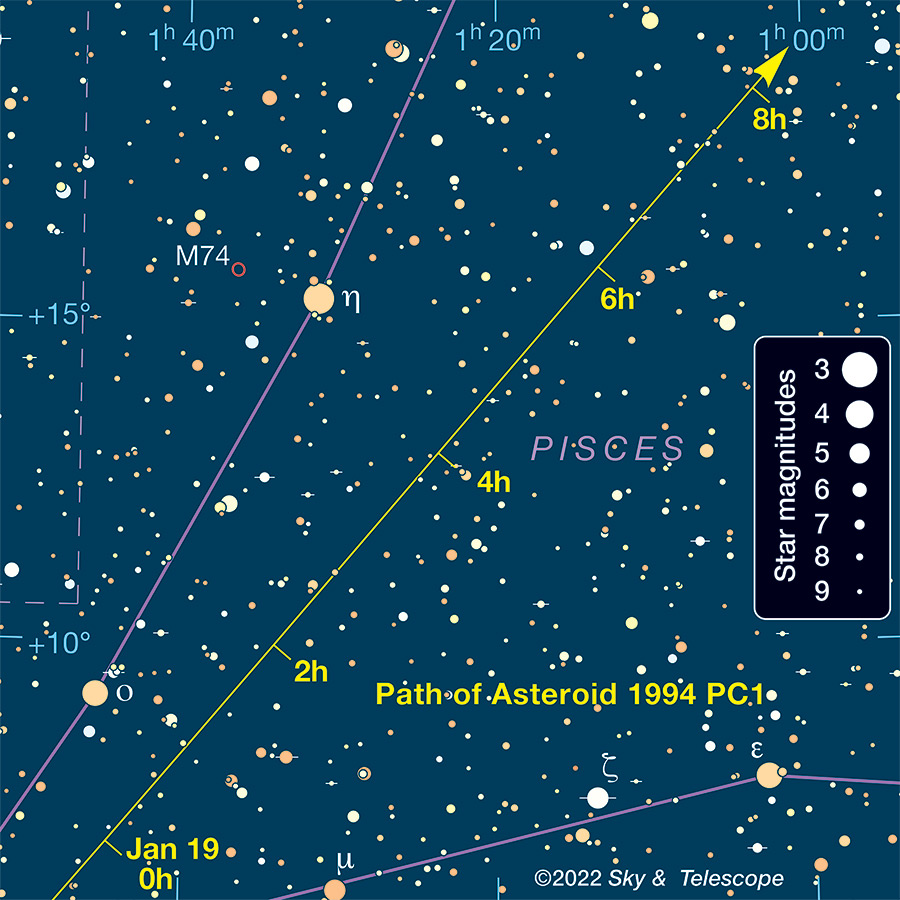
Sky & Telescope
Be aware that the Moon will be just past full and shines brightly in Cancer at the same time that the asteroid is best visible. But at magnitude 10–10.5 and with the Moon in the opposite part of the sky, it should still be accessible in a 4-inch telescope. It helps that 1994 PC1 is not only large but also a good reflector of light with an albedo of 0.28 (reflecting 28% of the light it receives from the Sun). That's about the same reflectance as grass or red brick. For comparison, Earth's albedo is 0.37 and the Moon's is 0.12.
The key to finding and following the minor planet is to locate a relatively bright star or star pattern on the map in advance of its arrival . . . and wait. Give yourself at least five minutes to familiarize yourself with the star field, so you can nab the intruder when the time is right. The closest-approaching PHAs move extremely rapidly and can be hard to track. Thankfully, 1994 PC1 isn't one of these speed demons, making it more accessible. It will look similar to a very slow-moving satellite.
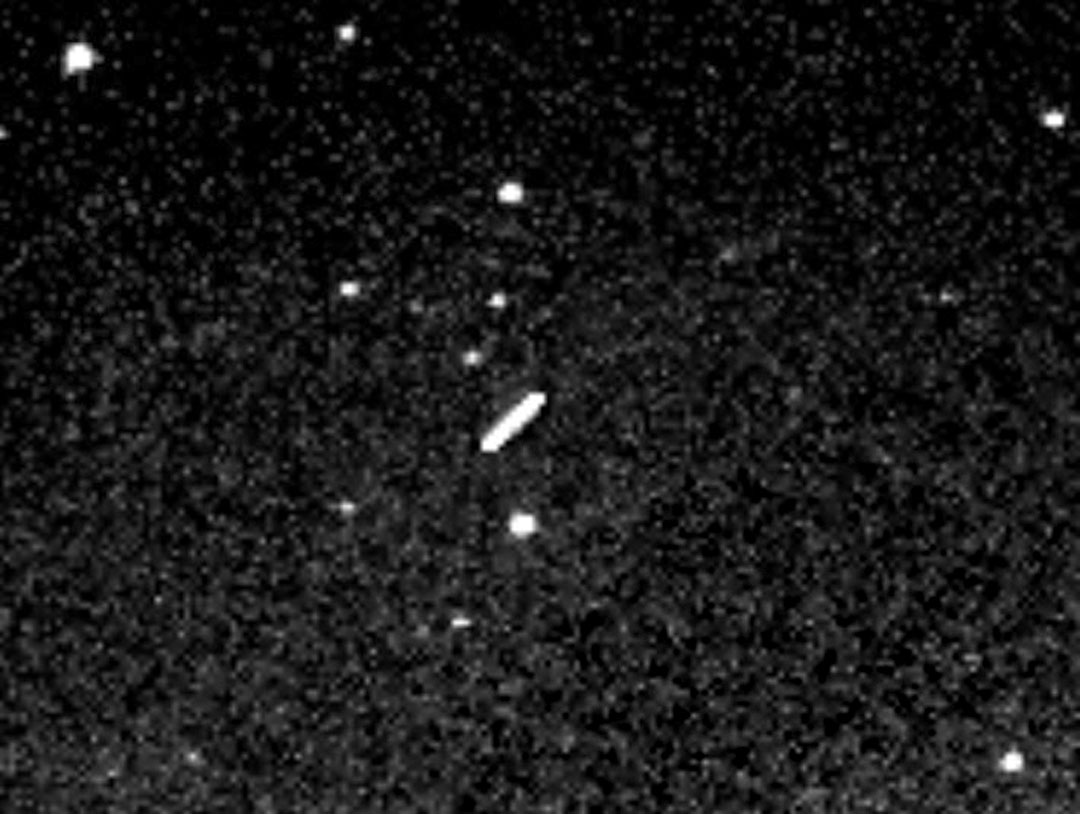
Francesco Manca / Sormano Astronomical Observatory
The charts here capture the asteroid at its brightest, but it remains above magnitude 13 from January 12–21, putting it within range of an 8-inch (200-mm) scope for more than a week. To stay hot on 1994 PC1's trail, try making your own customized maps. Input its orbital elements into a sky-mapping program such as SkySafari (Android / iOS), Stellarium, or Cartes du Ciel. You'll also find a regularly updated map on Gideon van Buitenen's 1994 PC1 page.

Michael Jäger
Don't have a scope? Watch a live view of the asteroid online on Gianluca Masi's Virtual Telescope Project site. Tune in starting at 3 p.m. EST (20:00 UT) on January 18th. Enjoy the ride!
 9
9









Comments
Frank-ReedNavigation.com
January 16, 2022 at 5:28 pm
The weather is looking relatively good at least for here in southern New England. Forecast calls for clear skies but very cold! Just before 6:30pm on Tueday, there's also a nice pass of the International Space Station almost directly overhead (as seen *specifically* from southern New England) before it passes into the Earth's shadow. The space station's ground track trends generally parallel to the US east coast. For observers along a track inland from there (e.g. up in Vermont), there are locations where the ISS would pass right through the telescopic field of view where the asteroid is passing. A worthy target... if you don't freeze!
You must be logged in to post a comment.
Frank-ReedNavigation.com
January 16, 2022 at 5:39 pm
The positions here are presumably geocentric. The observer-based (topocentric or altitude-driven) parallax can be as much 22 minutes of arc from one side of the Earth to the other. That's 11' in any direction from the geocentric center line as plotted. This is roughly the length of the yellow tick marks every two hours on the detailed finder charts. Not a big deal, of course.
Count this is a simple "heads up" that the exact position as observed will vary a bit. Of course the key to identification is motion which will certainly be obvious within a minute or two.
You must be logged in to post a comment.
Bob KingPost Author
January 17, 2022 at 1:58 am
Hi Frank,
Glad to hear the weather will be good. Yes, the positions are geocentric, and you're correct, the asteroid's position will vary somewhat from one side of the Earth to the other. Since the charts are centered over American time zones, the variation will be less, but still enough for a heads up. Thank you.
You must be logged in to post a comment.
Frank-ReedNavigation.com
January 18, 2022 at 8:17 pm
Just watched for a while, right around 0100 UT, as the asteroid glided ever so slowly through the stars of Pisces. It was around magnitude 10.5 +/-0.3 as expected. I did this the old-fashioned way by star-hopping, and I have to report, my biggest problem tonight was omicron (!) --omicron Piscium, that is. With the Full Moon, it was really tough to find that starting point in my star-hopping tour since it was only barely visible in the finder scope of my rather old telescope. Honestly, after cleaning the primary mirror last night and seeing how "porous" the reflecting surface has become in 46 years (this is a Criterion 6" Newtonian that I have had since I was 12 years old, never "re-silvered") I was surprised I could see down to magnitude 11.0 with a bright Full Moon in the sky.
You must be logged in to post a comment.
Bob KingPost Author
January 19, 2022 at 10:42 am
Glad you got to see it, Frank. I'm jealous. Clouds tore across the face of the Moon last night, but it never cleared enough to attempt to see the asteroid. It will still be visible tonight (Jan. 19) at around mag. 11 — but with a dimmer Moon!
You must be logged in to post a comment.
jmr
January 19, 2022 at 3:23 pm
A 6 inch Criterion owner !
I almost bought one in 1975 when working at the Gengras Planetarium in W. Hartford. Criterion even gave us a tour of the factory. It is a nice scope, but I waited to make an 8 inch in 1978, but my homemade Dobsonian mount was horrible ! The 6 inch Criterion was $200 back then !
John
You must be logged in to post a comment.
Joe Stieber
January 19, 2022 at 12:14 pm
Thanks for the heads-up Bob!
I was out to the New Jersey Pines for a few hours last night, 18-Jan-2022, under a bright, nearly-full moon and passing high thin clouds. Using my 115 mm (4.5 inch) apo spotting scope, I was able to pick up 1994 PC1 at 7:40 pm EST. I actually saw it a few minutes earlier, but wanted to confirm movement before declaring it found.
I continued to follow it until 8:10 pm, when I moved too far while tracking it, then got lost trying to backtrack. This scope is on a manual altazimuth mount (actually, a nice photo gimble head on a photo tripod). I don't use a finder scope, but at its lowest magnification, 30x, there's a 2° TFOV. The zoom eyepiece goes up to 70x with a 1° TFOV.
I finally reacquired the asteroid at 9:10 pm and followed it until 9:35 pm when I accidently exhaled on the eyepiece, fogging it up. I decided to pack up as I was becoming weary of standing in the cold (25°F) for a few hours. Mercifully, there was no wind, not even a light breeze.
I thought it was well worth the effort. I've seen a number of these fast-moving close asteroid passes before, but never tire of seeing them move in real time, like a slow-moving earth satellite.
Looking at a SkyTools chart this morning and comparing the asteroid to some of the field stars it passed, I would estimate it was around magnitude 10.5, While not bright in the absolute sense, once located in the 115 mm scope, it wasn't too difficult to see, despite the moon.
You must be logged in to post a comment.
jmr
January 19, 2022 at 3:20 pm
With clear skies in Richmond, Va, I tried for an hour with my 5 inch Celestron S/C to find 1994 near Alpha Pisces around 8 pm. However, lights of Richmond made it quite difficult to see even 3rd Mag stars in that part of the sky, which was over the Downtown.
I was real tired but now regret not setting up my 11 inch scope. I think that 10.5 magnitude may have been impossible for me, I should have started with the 11 inch.
John
You must be logged in to post a comment.
Bob KingPost Author
January 19, 2022 at 9:00 pm
Hi jmr,
So sorry you missed on the 18th. It's still easily accessible with that 11-inch however. While the asteroid will soon leave the chart, you can use JPL HORIZONS to get hour-by-hour coordinates and then just plot those using simple software like Stellarium. Any questions on exactly how to do this, just ask.
You must be logged in to post a comment.
You must be logged in to post a comment.